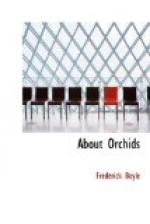of course, the last inch and a half filled with nectar.
Studying this appendage by the light of the principles
he had laid down, Darwin ventured on a prophecy which
roused special mirth among the unbelievers. Not
only the abnormal length of the nectary had to be considered;
there was, besides, the fact that all its honey lay
at the base, a foot or more from the orifice.
Accepting it as a postulate that every detail of the
apparatus must be equally essential for the purpose
it had to serve, he made a series of experiments which
demonstrated that some insect of Madagascar—doubtless
a moth—must be equipped with a proboscis
long enough to reach the nectar, and at the same time
thick enough at the base to withdraw the pollinia—thus
fertilizing the bloom. For, if the nectar had
lain so close to the orifice that moths with a proboscis
of reasonable length and thickness could get at it,
they would drain the cup without touching the pollinia.
Darwin never proved his special genius more admirably
than in this case. He created an insect beyond
belief, as one may say, by the force of logic; and
such absolute confidence had he in his own syllogism
that he declared, “If such great moths were
to become extinct in Madagascar, assuredly this Angraecum
would become extinct.” I am not aware that
Darwin’s fine argument has yet been clinched
by the discovery of that insect. But cavil has
ceased. Long before his death a sphinx moth arrived
from South Brazil which shows a proboscis between
ten and eleven inches long—very nearly equal,
therefore, to the task of probing the nectary of
Angraecum
sesquipidale. And we know enough of orchids
at this time to be absolutely certain that the Madagascar
species must exist.
FOOTNOTES:
[Footnote 4: Vide “The Lost Orchid,”
infra, p. 173.]
[Footnote 5: I have learned by a doleful experience
that this fly, commonly called “the weavil,”
is quite at home on Loelia purpurata; in fact,
it will prey on any Cattleya.]
HOT ORCHIDS.
In former chapters I have done my best to show that
orchid culture is no mystery. The laws which
govern it are strict and simple, easy to define in
books, easily understood, and subject to few exceptions.
It is not with Odontoglossums and Dendrobes as with
roses—an intelligent man or woman needs
no long apprenticeship to master their treatment.
Stove orchids are not so readily dealt with; but then,
persons who own a stove usually keep a gardener.
Coming from the hot lowlands of either hemisphere,
they show much greater variety than those of the temperate
and sub-tropic zones; there are more genera, though
not so many species, and more exceptions to every
rule. These, therefore, are not to be recommended
to all householders. Not everyone indeed is anxious
to grow plants which need a minimum night heat of
60 deg. in winter, 70 deg. in summer, and cannot dispense
with fire the whole year round.




